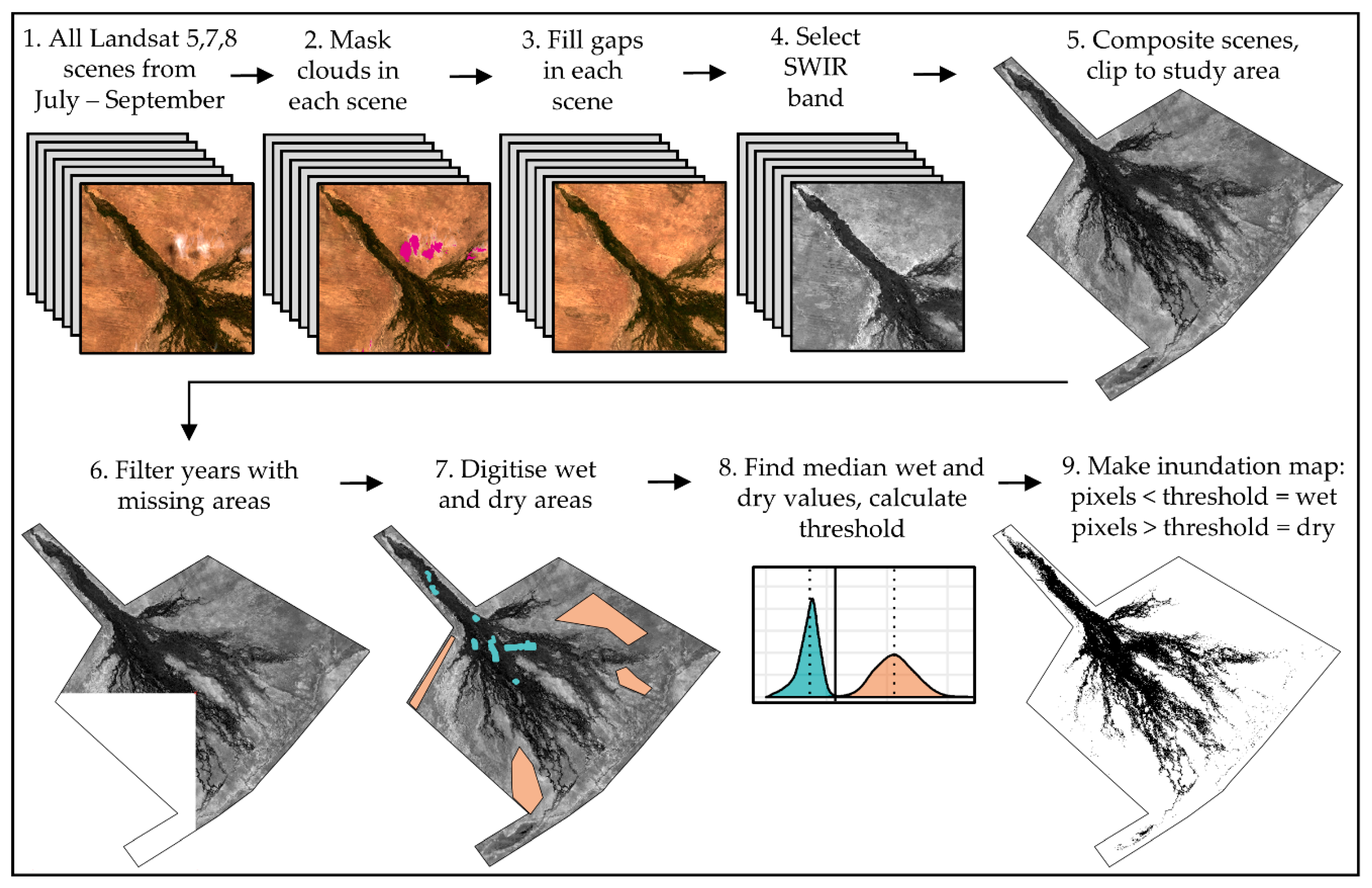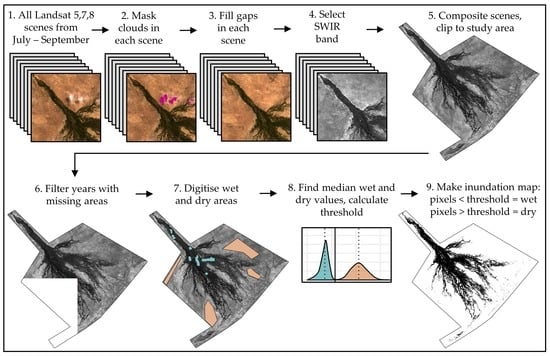Automated Inundation Mapping Over Large Areas Using Landsat Data and Google Earth Engine
Abstract
:1. Introduction
2. Materials and Methods
2.1. Annual (July–September) Landsat Composites
2.2. Annual (July–September) Inundation Maps
2.3. Validating Inundation Maps (Image-Based Accuracy Assessment)
2.4. Validating Inundation Maps (In Situ Data Accuracy Assessment)
3. Results
Validating Inundation Maps
4. Discussion
5. Conclusions
Supplementary Materials
Author Contributions
Funding
Acknowledgments
Conflicts of Interest
References
- Milzow, C.; Kgotlhang, L.; Bauer-Gottwein, P.; Meier, P.; Kinzelbach, W. Regional review: The hydrology of the Okavango Delta, Botswana—Processes, data and modelling. Hydrogeol. J. 2009, 17, 1297–1328. [Google Scholar] [CrossRef]
- Wolski, P.; Murray-Hudson, M. Reconstruction 1989-2005 inundation history in the Okavango Delta from archival LandSat TM imagery. In Proceedings of the Globewetlands Symposium, ESA-ESRIN, Rome, Italy, 19–20 October 2006. [Google Scholar]
- Ramsar Ramsar Sites Information Service. Available online: https://rsis.ramsar.org/ (accessed on 18 November 2019).
- Milzow, C.; Kgotlhang, L.; Kinzelbach, W.; Meier, P.; Bauer-Gottwein, P. The role of remote sensing in hydrological modelling of the Okavango Delta, Botswana. J. Environ. Manag. 2009, 90, 2252–2260. [Google Scholar] [CrossRef]
- Gumbricht, T.; McCarthy, J.; McCarthy, T.S. Channels, wetlands and islands in the Okavango Delta, Botswana, and their relation to hydrological and sedimentological processes. Earth Surf. Process. Landf. 2004, 29, 15–29. [Google Scholar] [CrossRef]
- Gumbricht, T.; Wolski, P.; Frost, P.; McCarthy, T.S. Forecasting the spatial extent of the annual flood in the Okavango Delta, Botswana. J. Hydrol. 2004, 290, 178–191. [Google Scholar] [CrossRef]
- McCarthy, T.S.; Bloem, A.; Larkin, P.A. Observations on the hydrology and geohydrology of the Okavango Delta. S. Afr. J. Geol. 1998, 101, 101–117. [Google Scholar]
- Thito, K.; Wolski, P.; Murray-Hudson, M. Mapping inundation extent, frequency and duration in the Okavango Delta from 2001 to 2012. Afr. J. Aquat. Sci. 2016, 41, 267–277. [Google Scholar] [CrossRef]
- Wolski, P.; Murray-Hudson, M.; Thito, K.; Cassidy, L. Keeping it simple: Monitoring flood extent in large data-poor wetlands using MODIS SWIR data. Int. J. Appl. Earth Obs. Geoinf. 2017, 57, 224–234. [Google Scholar] [CrossRef] [Green Version]
- McCarthy, J.M.; Gumbricht, T.; McCarthy, T.; Frost, P.; Wessels, K.; Seidel, F. Flooding patterns of the Okavango Wetland in Botswana between 1972 and 2000. Ambio 2003, 32, 453–457. [Google Scholar] [CrossRef]
- Department of Environmental Affairs. Okavango Delta Management Plan; Ministry of Environment, Wildlife, and Tourism: Gaborone, Botswana, 2008.
- Ramberg, L.; Hancock, P.; Lindholm, M.; Meyer, T.; Ringrose, S.; Sliva, J.; Van As, J.; VanderPost, C. Species diversity of the Okavango Delta, Botswana. Aquat. Sci. 2006, 68, 310–337. [Google Scholar] [CrossRef]
- Fluet-Chouinard, E.; Lehner, B.; Rebelo, L.M.; Papa, F.; Hamilton, S.K. Development of a global inundation map at high spatial resolution from topographic downscaling of coarse-scale remote sensing data. Remote Sens. Environ. 2015, 158, 348–361. [Google Scholar] [CrossRef]
- Ringrose, S.; Vanderpost, C.; Matheson, W. Mapping ecological conditions in the Okavango delta, Botswana using fine and coarse resolution systems including simulated SPOT vegetation imagery. Int. J. Remote Sens. 2003, 24, 1029–1052. [Google Scholar] [CrossRef]
- Murray-Hudson, M.; Wolski, P.; Cassidy, L.; Brown, M.T.; Thito, K.; Kashe, K.; Mosimanyana, E. Remote Sensing-derived hydroperiod as a predictor of floodplain vegetation composition. Wetl. Ecol. Manag. 2015, 23, 603–616. [Google Scholar] [CrossRef]
- Islam, A.S.; Bala, S.K.; Haque, M.A. Flood inundation map of Bangladesh using MODIS time-series images. J. Flood Risk Manag. 2010, 3, 210–222. [Google Scholar] [CrossRef]
- Kalluri, S.; Gilruth, P.; Bergman, R. The potential of remote sensing data for decision makers at the state, local and tribal level: Experiences from NASA’s Synergy program. Environ. Sci. Policy 2003, 6, 487–500. [Google Scholar] [CrossRef]
- Ouellette, W.; Getinet, W. Remote sensing for Marine Spatial Planning and Integrated Coastal Areas Management: Achievements, challenges, opportunities and future prospects. Remote Sens. Appl. Soc. Environ. 2016, 4, 138–157. [Google Scholar] [CrossRef]
- Hermon, D. Land Stability Model for Sustainable Spatial Planning in Padang City-Indonesia based on Landslide Disaster. J. Geogr. Earth Sci. 2019, 7, 19–26. [Google Scholar] [CrossRef]
- Heiskanen, J.; Liu, J.; Valbuena, R.; Aynekulu, E.; Packalen, P.; Pellikka, P. Remote sensing approach for spatial planning of land management interventions in West African savannas. J. Arid Environ. 2017, 140, 29–41. [Google Scholar] [CrossRef] [Green Version]
- Seto, K.C.K.; Woodcock, C.E.C.E.; Song, C.; Huang, X.; Lu, J.; Kaufmann, R.K. Monitoring land-use change in the Pearl River Delta using Landsat TM. Int. J. Remote Sens. 2002, 23, 1985–2004. [Google Scholar] [CrossRef]
- Fu, P.; Weng, Q. A time series analysis of urbanization induced land use and land cover change and its impact on land surface temperature with Landsat imagery. Remote Sens. Environ. 2016, 175, 205–214. [Google Scholar] [CrossRef]
- Allen, R.G.; Tasumi, M.; Morse, A.; Trezza, R. A landsat-based energy balance and evapotranspiration model in Western US water rights regulation and planning. Irrig. Drain. Syst. 2005, 19, 251–268. [Google Scholar] [CrossRef]
- Bechtel, R.; Sánchez-Azofeifa, A.; Rivard, B.; Hamilton, G.; Martin, J.; Dzus, E. Associations between Woodland Caribou telemetry data and Landsat TM spectral reflectance. Int. J. Remote Sens. 2004, 25, 4813–4828. [Google Scholar] [CrossRef]
- Simons-Legaard, E.M.; Harrison, D.J.; Legaard, K.R. Habitat monitoring and projections for Canada lynx: Linking the Landsat archive with carnivore occurrence and prey density. J. Appl. Ecol. 2016, 53, 1260–1269. [Google Scholar] [CrossRef] [Green Version]
- Ticehurst, C.; Dutta, D.; Karim, F. Improving the accuracy of daily MODIS OWL flood inundation mapping using hydrodynamic modelling. Nat. Hazards 2015, 78, 803–820. [Google Scholar] [CrossRef]
- Chen, Y.; Huang, C.; Ticehurst, C.; Merrin, L.; Thew, P. An Evaluation of MODIS Daily and 8-day Composite Products for Floodplain and Wetland Inundation Mapping. Wetlands 2013, 33, 823–835. [Google Scholar] [CrossRef]
- Fayne, J.V.; Bolten, J.D.; Doyle, C.S.; Fuhrmann, S.; Matthew, T.; Houser, P.R.; Lakshmi, V.; Fayne, J.V.; Bolten, J.D.; Doyle, C.S.; et al. Flood mapping in the lower Mekong River Basin using daily MODIS observations Flood mapping in the lower Mekong River Basin using daily MODIS observations. Int. J. Remote Sens. 2017, 38, 1737–1757. [Google Scholar] [CrossRef]
- Danaher, T.; Flood, N. A Comparison of Woody Change Mapping based on SPOT 5 and Landsat TM Imagery Using 2010—2011 Imagery; Office of Environment and Heritage: Sydney, Australia, 2014.
- Li, L.; Chen, Y.; Yu, X.; Liu, R.; Huang, C. Sub-pixel flood inundation mapping from multispectral remotely sensed images based on discrete particle swarm optimization. ISPRS J. Photogramm. Remote Sens. 2015, 101, 10–21. [Google Scholar] [CrossRef]
- Verhoeye, J.; De Wulf, R. Land cover mapping at sub-pixel scales using linear optimization techniques. Remote Sens. Environ. 2002, 79, 96–104. [Google Scholar] [CrossRef]
- Gorelick, N.; Hancher, M.; Dixon, M.; Ilyushchenko, S.; Thau, D.; Moore, R. Google Earth Engine: Planetary-scale geospatial analysis for everyone. Remote. Sens. Environ. 2017, 202, 18–27. [Google Scholar] [CrossRef]
- Thalefang, C. Why Okavango Delta is drying—Experts speak. Mmegi Online. 2019, pp. 1–11. Available online: https://www.mmegi.bw/index.php?aid=82034&dir=2019%2Faugust%2F02 (accessed on 2 March 2020).
- Scaramuzza, P.; Micijevic, E.; Chander, G. SLC-Off Gap-Filled Products: Gap-Fill Algorithm Methodology; US Geological Survey Earth Resources Observation and Science (EROS) Center, 2004. Available online: https://landsat.usgs.gov/sites/default/files/documents/L7SLCGapFilledMethod.pdf (accessed on 2 March 2020).
- Olofsson, P.; Foody, G.M.; Herold, M.; Stehman, S.V.; Woodcock, C.E.; Wulder, M.A. Good practices for estimating area and assessing accuracy of land change. Remote Sens. Environ. 2014, 148, 42–57. [Google Scholar] [CrossRef]
- Iwao, K.; Nishida, K.; Kinoshita, T.; Yamagata, Y. Validating land cover maps with Degree Confluence Project information. Geophys. Res. Lett. 2006, 33, 1–5. [Google Scholar] [CrossRef]
- Montesano, P.M.; Nelson, R.; Sun, G.; Margolis, H.; Kerber, A.; Ranson, K.J. MODIS tree cover validation for the circumpolar taiga – tundra transition zone. Remote Sens. Environ. 2009, 113, 2130–2141. [Google Scholar] [CrossRef] [Green Version]
- Luedeling, E.; Buerkert, A. Typology of oases in northern Oman based on Landsat and SRTM imagery and geological survey data. Remote Sens. Environ. 2008, 112, 1181–1195. [Google Scholar] [CrossRef]
- Bastin, L.; Buchanan, G.; Beresford, A.; Pekel, J.; Dubois, G. Ecological Informatics Open-source mapping and services for Web-based land-cover validation. Ecol. Inform. 2013, 14, 9–16. [Google Scholar] [CrossRef] [Green Version]
- Strand, G.; Dramstad, W.; Engan, G. The effect of field experience on the accuracy of identifying land cover types in aerial photographs. Int. J. Appl. Earth Obs. Geoinf. 2002, 4, 137–146. [Google Scholar] [CrossRef]
- Silvestri, S.; Omri, M. A method for the remote sensing identification of uncontrolled landfills: Formulation and validation. Int. J. Remote Sens. 2008, 29, 975–989. [Google Scholar] [CrossRef]
- Hijmans, R.J. raster: Geographic Data Analysis and Modeling. R Package Version 3.0-7. 2019. Available online: http://CRAN.R-project.org/package=raster (accessed on 2 March 2020).
- R Core Team. R: A Language and Environment for Statistical Computing; R Foundation for Statistical Computing: Vienna, Austria, 2018. [Google Scholar]
- QGIS Development Team. QGIS Geographic Information System. Open Source Geospatial Foundation Project. 2018. Available online: http://qgis.osgeo.org (accessed on 2 March 2020).
- Wolski, P.; Murray-Hudson, M. Recent changes in flooding in the Xudum distributary of the Okavango Delta and Lake Ngami, Botswana. S. Afr. J. Sci. 2006, 102, 173–176. [Google Scholar]
- McCarthy, T.S.; Ellery, W.N.; Stanistreet, I.G. Avulsion mechanisms on the Okavango fan, Botswana: The control of a fluvial system by vegetation. Sedimentology 1992, 39, 779–795. [Google Scholar] [CrossRef]
- McCarthy, T.S.; Cooper, G.R.J.; Tyson, P.D.; Ellery, W.N. Seasonal flooding in the Okavango Delta, Botswana—Recent history and future prospects. S. Afr. J. Sci. 2000, 96, 25–33. [Google Scholar]
- Tyson, P.D.; Cooper, G.R.J.; McCarthy, T.S. Millennial to multi-decadal variability in the climate of southern Africa. Int. J. Climatol. 2002, 22, 1105–1117. [Google Scholar] [CrossRef]
- Murray-Hudson, M.; Wolski, P.; Ringrose, S. Scenarios of the impact of local and upstream changes in climate and water use on hydro-ecology in the Okavango Delta, Botswana. J. Hydrol. 2006, 331, 73–84. [Google Scholar] [CrossRef]
- Hlavka, C.A.; Livingston, G.P. Statistical models of fragmented land cover and the effect of coarse spatial resolution on the estimation of area with satellite sensor imagery. Int. J. Remote Sens. 1997, 18, 2253–2259. [Google Scholar] [CrossRef]
- Loboda, T. Estimating burned area from AVHRR and MODIS: Validation results and sources of error. Proc. Curr. Asp. Rem. 2004, 2, 415–421. [Google Scholar]
- Moody, A.; Woodcock, C.E. Scale-dependent errors in the estimation of land-cover proportions: Implications for global land-cover datasets. Photogramm. Eng. Remote Sens. 1994, 60, 585–594. [Google Scholar]
- Ozdogan, M.; Woodcock, C.E. Resolution dependent errors in remote sensing of cultivated areas. Remote Sens. Environ. 2006, 103, 203–217. [Google Scholar] [CrossRef]
- McCarthy, J. Remote Sensing for Detection of Landscape Form and Function of the Okavango Delta Botswana. Ph.D. Thesis, Department of Land and Water Resources Engineering, KTH, Stockholm, Sweden, 12 April 2002. ISBN 9172832495. Available online: kth.diva-portal.org/smash/record/jsf?pid=diva2%3A9101&dswid=4172 (accessed on 2 March 2020).





| Landsat | Hi-res Visual Interp. | In Situ | |||||
|---|---|---|---|---|---|---|---|
| Dry | Wet | Dry | Wet | Dry | Wet | ||
| Map | Dry | 526 | 10 | 82 | 3 | 45 [44] | 1 [0] |
| Wet | 3 | 152 | 2 | 36 | 8 [2] | 52 [52] | |
| Overall accuracy | 98.1% (678/691) | 95.9% (118/123) | 91.5% (97/106) [98.0% (96/98)] | ||||
© 2020 by the authors. Licensee MDPI, Basel, Switzerland. This article is an open access article distributed under the terms and conditions of the Creative Commons Attribution (CC BY) license (http://creativecommons.org/licenses/by/4.0/).
Share and Cite
Inman, V.L.; Lyons, M.B. Automated Inundation Mapping Over Large Areas Using Landsat Data and Google Earth Engine. Remote Sens. 2020, 12, 1348. https://doi.org/10.3390/rs12081348
Inman VL, Lyons MB. Automated Inundation Mapping Over Large Areas Using Landsat Data and Google Earth Engine. Remote Sensing. 2020; 12(8):1348. https://doi.org/10.3390/rs12081348
Chicago/Turabian StyleInman, Victoria L., and Mitchell B. Lyons. 2020. "Automated Inundation Mapping Over Large Areas Using Landsat Data and Google Earth Engine" Remote Sensing 12, no. 8: 1348. https://doi.org/10.3390/rs12081348
APA StyleInman, V. L., & Lyons, M. B. (2020). Automated Inundation Mapping Over Large Areas Using Landsat Data and Google Earth Engine. Remote Sensing, 12(8), 1348. https://doi.org/10.3390/rs12081348







